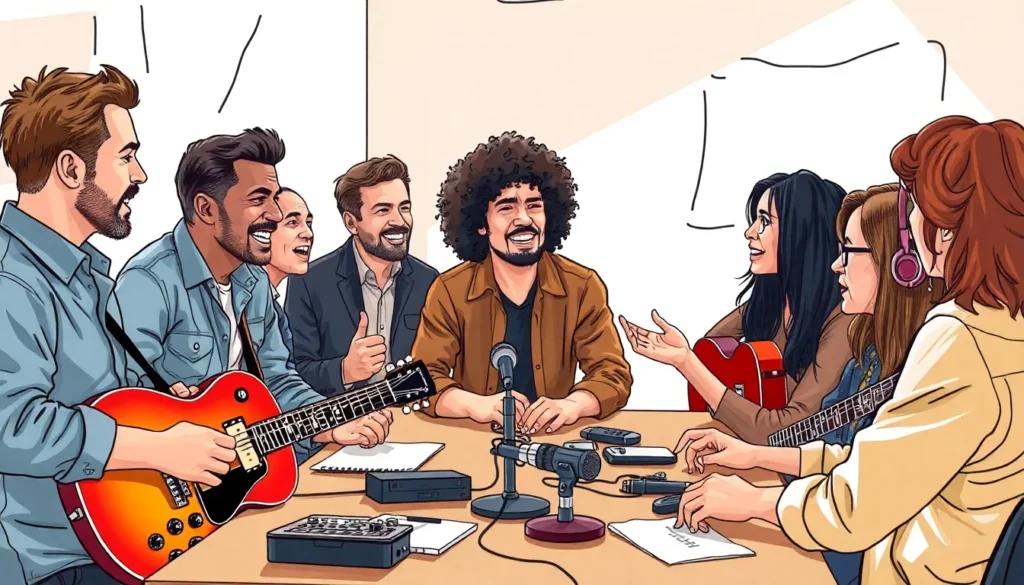The music industry isn’t just about catchy hooks and viral dance moves; it’s a battleground of ideas, opinions, and sometimes, downright drama. From streaming royalties that make artists’ heads spin to the age-old vinyl versus digital debate, the conversations are as diverse as the genres themselves. Everyone’s got an opinion, and trust us, they’re not shy about sharing it.
Table of Contents
ToggleOverview of Music Industry Debates
The music industry encompasses a range of contentious topics, reflecting its dynamic and multifaceted nature. One major debate centers on streaming royalties, where artists often express dissatisfaction with the compensation models set by platforms. Many argue that these models disproportionately favor larger record labels, leaving smaller artists struggling for fair pay.
Another prominent issue involves the vinyl versus digital format debate. Advocates for vinyl emphasize the tangible and nostalgic aspects of records, while supporters of digital highlight convenience and accessibility. Both viewpoints promote valuable discussions about the future of music consumption and the significance of physical versus digital ownership.
Additionally, the rise of artificial intelligence in music production raises questions about authenticity and creativity. Some individuals welcome AI as an innovative tool that enhances artistic possibilities, whereas others fear it threatens the integrity of human artistry. These perspectives generate significant dialogue about the role of technology in the creative process.
Furthermore, debates often arise around music copyright laws, particularly in an era marked by rapid sharing and remixing. Artists and legal experts work to balance protecting intellectual property while fostering creativity and collaboration. This ongoing discussion highlights the evolving nature of copyright in the digital age.
Conversations about diversity and representation also shape industry debates. Industry stakeholders examine how race, gender, and socio-economic factors influence opportunities in music. Investigating these factors brings attention to the need for systemic changes to ensure a more equitable landscape.
In sum, the music industry showcases a variety of viewpoints on essential issues, with each debate driving important conversations that impact artists, consumers, and the broader cultural landscape.
Key Issues in the Music Industry

The music industry faces numerous challenges that shape its future. Key issues revolve around artist compensation and the differences between streaming and traditional sales.
Artist Compensation
Artist compensation remains a contentious topic within the industry. Many artists express dissatisfaction with streaming platforms that often allocate a majority of revenue to larger record labels. On average, artists receive only $0.003 to $0.005 per stream, which many deem insufficient. Small and independent artists especially struggle to gain fair financial returns. Some initiatives advocate for better payment structures that prioritize artists’ earnings to ensure sustainability. Transparent reporting from streaming services could foster trust and promote equitable compensation practices.
Streaming vs. Traditional Sales
The debate between streaming and traditional sales presents diverse viewpoints regarding music consumption. Streaming platforms dominate the market, accounting for over 80% of music revenue in recent years. Traditional sales, such as vinyl and CDs, see renewed interest, especially among collectors. Advocates for vinyl highlight its tangible nature and sound quality, arguing it fosters a deeper connection to music. In contrast, supporters of streaming praise its accessibility and convenience for listeners. Ultimately, consumer preferences shape the evolving landscape of music formats, impacting both artist exposure and revenue generation.
Impact of Technology on Music
Technology significantly shapes the music landscape, influencing how music is distributed and consumed. Digital platforms and social media play crucial roles in this transformation.
Digital Distribution
Digital distribution revolutionizes how music reaches audiences. Streaming services dominate, contributing to over 80% of music revenue. Artists face challenges with low streaming payouts, receiving only $0.003 to $0.005 per stream. This financial model favors large record labels, prompting discussions on more equitable compensation. Nevertheless, digital platforms provide independent artists with unprecedented access to global audiences. Direct-to-consumer sales empower musicians to retain more control over their work and revenue streams. New distribution models continue to evolve, pushing boundaries in the industry.
Social Media Influence
Social media profoundly impacts music promotion and artist visibility. Platforms like Instagram, TikTok, and YouTube allow artists to build their brands and connect directly with fans. Engaging content drives virality, enabling songs to gain traction quickly. For instance, TikTok’s short video format often leads to significant exposure, turning unknown songs into chart-toppers. Artists leverage social media for marketing and community building, enhancing their reach without traditional media intermediaries. Higher engagement rates lead to more lucrative opportunities, such as brand partnerships and live performances. The relationship between artists and fans continues to strengthen in this digital age.
The Role of Record Labels
Record labels play a pivotal role in the music industry. These entities influence how artists produce, distribute, and promote their music. A major challenge arises when artists feel undercompensated. Streaming royalties often favor larger labels, resulting in artists receiving as little as $0.003 to $0.005 per stream, a rate that generates ongoing debates about fair pay.
Artists typically rely on record labels for funding and marketing support. The support provided helps artists reach wider audiences, yet it comes with contractual obligations that can restrict creative control. Such agreements often limit an artist’s ability to produce music outside what the label deems commercially viable.
Record labels are also known for shaping trends and genres within the industry. They determine which artists receive heavy promotion and which styles gain visibility. This power impacts public perception and consumes music trends, contributing to discussions about cultural representation and diversity.
In this changing landscape, independent artists increasingly seek alternatives. Many choose to bypass traditional labels, opting for self-publishing and social media promotions. The digital revolution makes it easier for artists to connect directly with audiences, fostering greater creativity and innovation.
In light of all these factors, the role of record labels is continuously evolving. While they remain influential, the rise of independent voices and digital platforms challenges their traditional dominance. Conversations surrounding their impact highlight larger issues related to artist rights and industry dynamics.
Future of Music Industry Debates
Ongoing debates within the music industry focus on key areas expected to shape its future. Streaming compensation continues to provoke discussions, as artists voice frustrations over receiving merely $0.003 to $0.005 per stream. Many advocate for more equitable payment structures that directly benefit artists rather than favoring larger record labels.
Emerging technologies, including artificial intelligence, spark heated conversations about creativity and authenticity. Artists grapple with AI’s potential to replicate their work, creating a divide between those who embrace its possibilities and those who question its impact on human artistry. Such discussions will likely evolve as AI capabilities advance.
The vinyl versus digital debate remains relevant as collectors revitalize interest in physical formats. Although streaming platforms account for over 80% of music revenue, a segment of the market shows a growing preference for tangible media. This trend might influence how music is marketed and consumed in the coming years.
Diversity and representation in the industry continually prompt dialogue. Artists from various backgrounds strive for greater visibility and opportunities. Their voices reflect the ever-changing dynamics related to race, gender, and socio-economic factors.
Technology’s role in redefining music access and artist engagement cannot be understated. Social media platforms play a critical role in connecting independent artists with global audiences. This shift not only enhances visibility but also fosters community and allows musicians to cultivate deeper relationships with fans.
Finally, the influence of record labels deserves attention. They traditionally control production and promotion yet face increasing pressure to adapt to independent artists’ needs. Conversations around artist rights and label obligations will likely remain pivotal as the music landscape evolves.
The music industry remains a dynamic and multifaceted arena where debates shape its future. As artists navigate the complexities of streaming royalties and the resurgence of vinyl, their voices are crucial in advocating for fair compensation and representation. The rise of technology and social media continues to redefine how music is consumed and marketed, creating new opportunities alongside significant challenges.
With ongoing discussions about creativity in the age of artificial intelligence and the influence of record labels, the industry is poised for transformation. Each debate not only reflects the diverse opinions within the music community but also highlights the need for continued dialogue. As these conversations evolve, they’ll play a vital role in shaping a more equitable and innovative music landscape.





